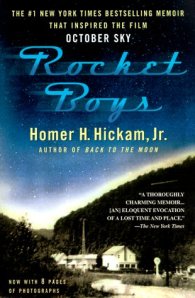 Growing up, I was never a science kid. Anyone who knows me knows this isn’t at all surprising, as I am even less of a math person – give me English, history, or the social sciences any day of the week! But reading Rocketboys was the chance to see what it would be like to indeed be a science kid, the kind of person who can look at pages full of equations, diagrams, and numbers and see not chaos, but something supremely beautiful, bordering on magic. That’s the kind of experience Homer Hickam Jr. tells in Rocket Boys, a book that was turned in to the AH-MAZING Jake Gyllenhaal movie October Sky. Homer and his friend Odell, Roy Lee, Quentin, and Sherman were all teenagers in 1950’s West Virginia, living in a small mining town named Coalwood, deep in the valleys of the Appalachian mountains. Fascinated by space and the launch of Sputnik satellite, Homer and his friend learn everything they can about building rockets – through trial and error, self-teaching from textbooks, and the support of a speculative and unsure, but ultimately loyal, community. The boys end up winning the National Science Fair, and many of them go on to careers involving the space program.
Growing up, I was never a science kid. Anyone who knows me knows this isn’t at all surprising, as I am even less of a math person – give me English, history, or the social sciences any day of the week! But reading Rocketboys was the chance to see what it would be like to indeed be a science kid, the kind of person who can look at pages full of equations, diagrams, and numbers and see not chaos, but something supremely beautiful, bordering on magic. That’s the kind of experience Homer Hickam Jr. tells in Rocket Boys, a book that was turned in to the AH-MAZING Jake Gyllenhaal movie October Sky. Homer and his friend Odell, Roy Lee, Quentin, and Sherman were all teenagers in 1950’s West Virginia, living in a small mining town named Coalwood, deep in the valleys of the Appalachian mountains. Fascinated by space and the launch of Sputnik satellite, Homer and his friend learn everything they can about building rockets – through trial and error, self-teaching from textbooks, and the support of a speculative and unsure, but ultimately loyal, community. The boys end up winning the National Science Fair, and many of them go on to careers involving the space program.
This book made me interested in rockets and physics and chemistry in a way that no book has since I read The Canon: A Whirligig Tour of the Beautiful Basics of Science by Natalie Angier. Not only does Homer do a great job of breaking down the science and taking the reader through his thought process as he and the boys tried and failed and tried again. But more pervasive throughout the book is the feeling that Homer has of not belonging, of being a part of a community that just can’t understand why and how a boy like Homer Hickam is supposed to go to college and join the likes of Warner Vaun Braun in the space program. The feeling of being suffocated by the community and physical geography around you is made crystal clear, as Homer describes time and time again how the mountains that surround his village, at once beautiful and comforting, are also a physical manifestation of his feelings of being trapped in a place that he desperately wants to escape.
By the end of the book, Homer comes to realize that it isn’t that he doesn’t belong in Coalwood – indeed, the people of his town made him who he was, that from them he learned resilience, hard work, and supreme loyalty. One thing I haven’t mentioned yet is the tension established between Homer, his father Homer Sr., his mother Elsie, and the Coalwood Mining Co. Homer’s father is unable to show any kind of sensitivity towards his younger son, who he can’t understand and has nothing in common with (as opposed to Homer’s older brother, Jim, a football star). Homer’s mother tries, and loves Homer, and hates the way his father treats him, but is ultimately the loyal wife. Homer Sr., however, is a company man, and will do any and everything the company asks. As the book progresses, we begin to see that there’s more to Homer Sr. than meets the eye, but we never quite come to a place of complete redemption where he is concerned.
None of these thoughts are coherent. I blame lack of sleep for that – the semester just finished up, but I promised myself I’d get this up before I go hibernate take a nap. Long story short: West Virginia sounds beautiful; coal mining would suck; space is cool, but I still am really bad at science; this is one of the few books that also made an awesome movie.
Rating: Hell yeah!
